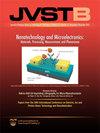New leak elements for helium based on single-layer graphene composite membranes
IF 1.4
4区 工程技术
引用次数: 0
Abstract
Graphene containing intrinsic pores with molecular dimensions is a highly promising material for standard leak elements because of its minimal and stable gas flow. However, the etching of polymethyl methacrylate (PMMA) during the typical graphene transfer process can cause the rupture of graphene on the porous substrate due to the surface tension as the etchant solution dries out. In this article, we simplified the typical graphene transfer process that enabled the transfer of a PMMA/graphene composite membrane onto a macroporous Cu gasket as the leak element and tested the leak rate, time stability, and response time of the composite membrane. The membrane permeation area depends on the pore size of the Cu substrate, which can be controlled by laser ablation or computer numerical control milling. To ensure the accuracy of time stability, the entire test lasted 60 days. The conductance results for two devices with a permeation size of 50 and 500 μm were about 10−17 and 10−14 m3 s−1, and the maximum variation of conductance in 60 days was 14% and 2.6%, respectively. Accordingly, the permeance of the composite membrane for helium can be calculated as 4.17 × 10−12–1.09 × 10−11 Pa m3 (cm2 s Pa)−1. Moreover, the composite membrane has been proven to have a rapid response of about 2 s to the upstream pressure.基于单层石墨烯复合膜的新型氦泄漏元件
石墨烯含有具有分子尺寸的固有孔隙,由于其最小且稳定的气体流动,是一种非常有前途的标准泄漏元件材料。然而,在典型的石墨烯转移过程中,聚甲基丙烯酸甲酯(PMMA)的蚀刻会导致多孔基底上的石墨烯由于蚀刻液干燥时的表面张力而破裂。在本文中,我们简化了典型的石墨烯转移过程,将PMMA/石墨烯复合膜转移到大孔铜衬垫上作为泄漏元件,并测试了复合膜的泄漏率、时间稳定性和响应时间。膜的渗透面积取决于Cu衬底的孔径大小,可以通过激光烧蚀或计算机数控铣削来控制。为了保证时间的准确性和稳定性,整个测试持续了60天。在渗透尺寸为50 μm和500 μm时,两种器件的电导结果分别为10−17和10−14 m3 s−1,60 d内电导的最大变化分别为14%和2.6%。据此,复合膜对氦的透过率可计算为4.17 × 10−12-1.09 × 10−11 Pa m3 (cm2 s Pa)−1。此外,复合膜已被证明对上游压力有大约2s的快速响应。
本文章由计算机程序翻译,如有差异,请以英文原文为准。
求助全文
约1分钟内获得全文
求助全文
来源期刊

Journal of Vacuum Science & Technology B
工程技术-工程:电子与电气
自引率
14.30%
发文量
0
审稿时长
2.5 months
期刊介绍:
Journal of Vacuum Science & Technology B emphasizes processing, measurement and phenomena associated with micrometer and nanometer structures and devices. Processing may include vacuum processing, plasma processing and microlithography among others, while measurement refers to a wide range of materials and device characterization methods for understanding the physics and chemistry of submicron and nanometer structures and devices.
 求助内容:
求助内容: 应助结果提醒方式:
应助结果提醒方式:


